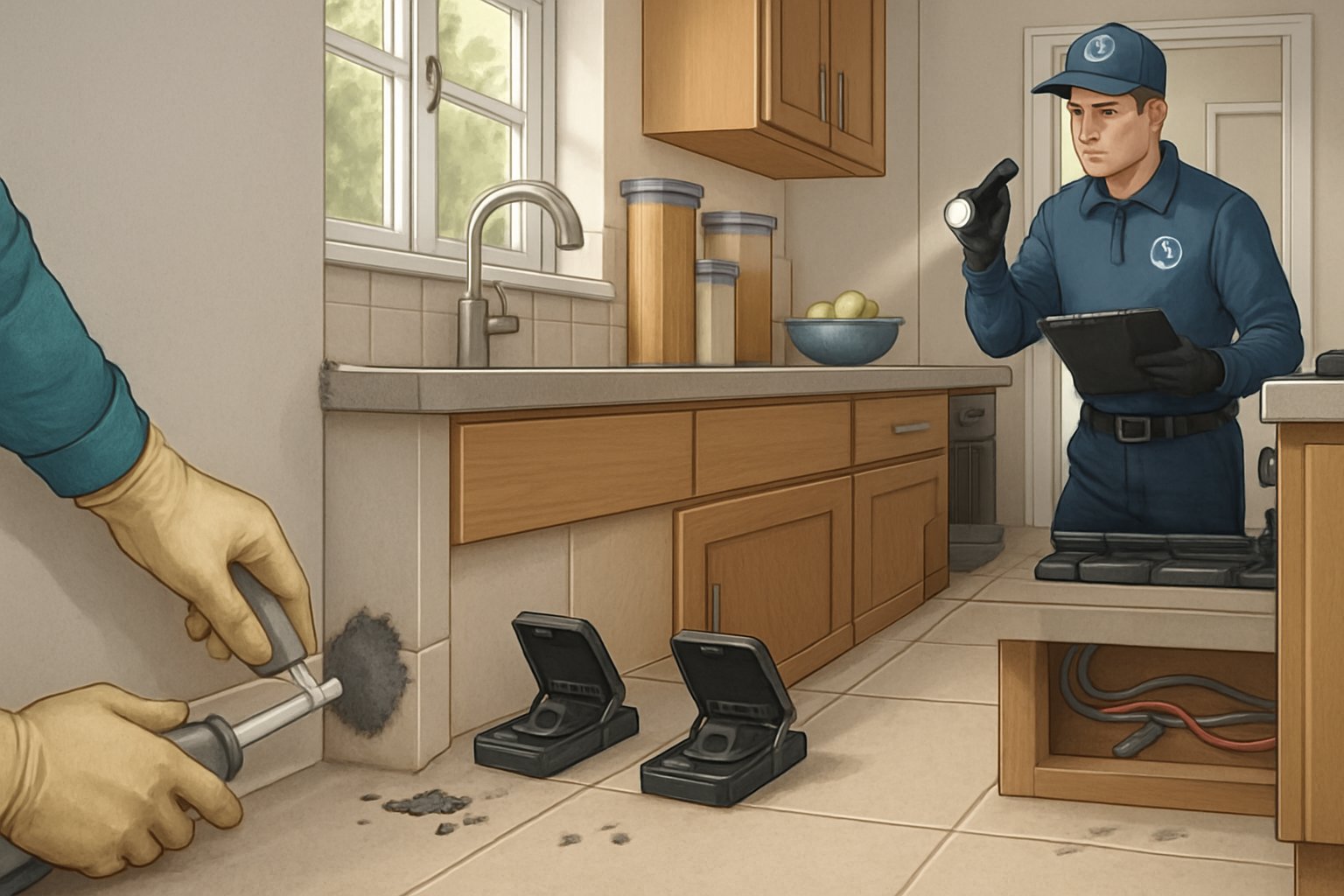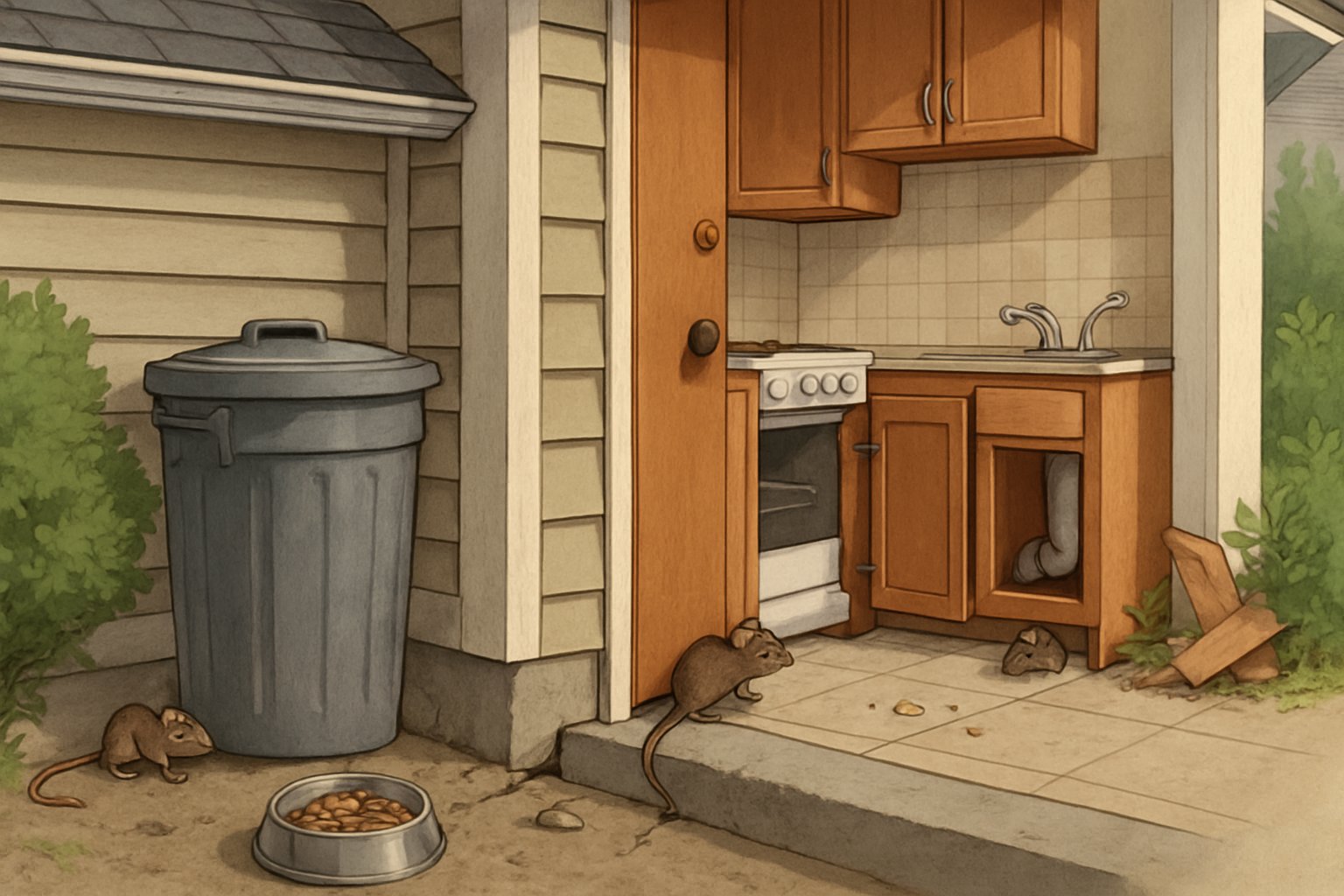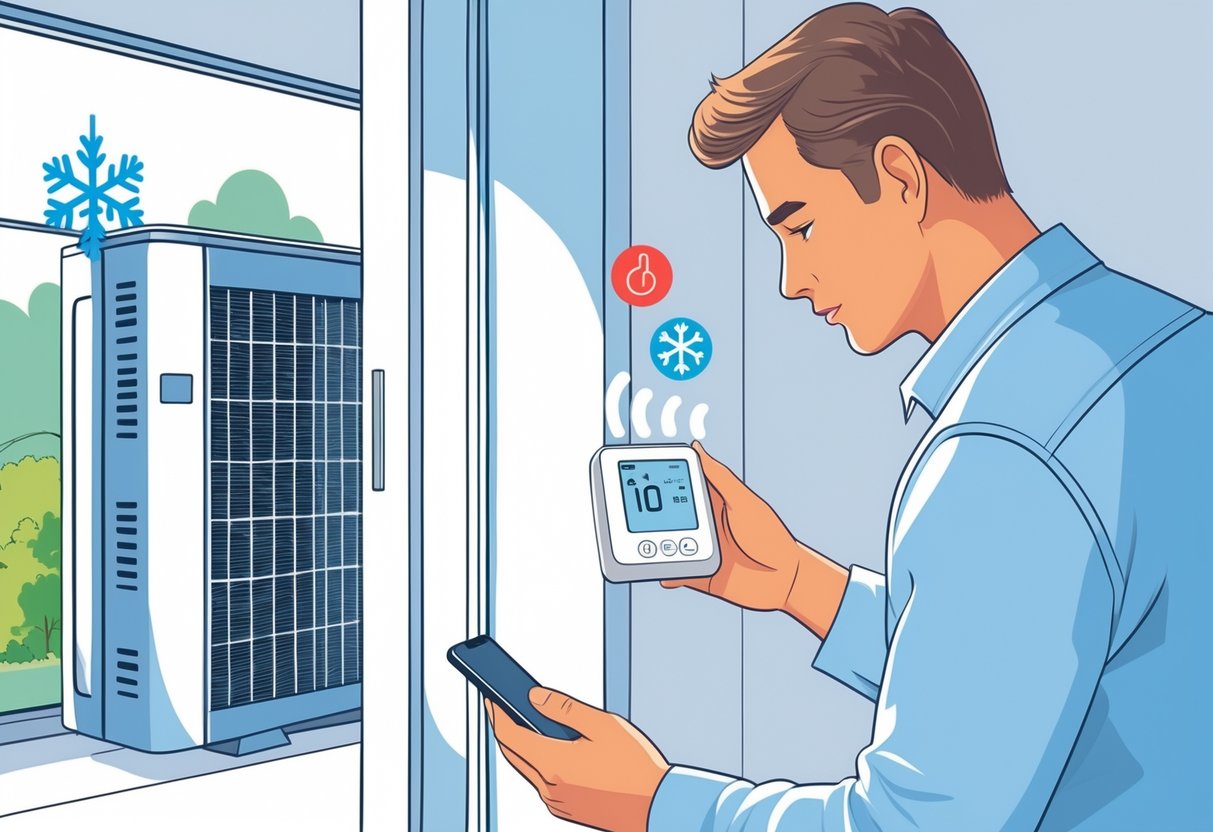Most homeowners wonder whether they should handle a mouse problem on their own or bring in a professional. Mice breed so fast—a tiny issue can turn into a full-blown infestation in just a few weeks.

Call a pest control professional if your DIY traps haven’t worked after two weeks, or if you spot droppings, gnaw marks, or hear scratching sounds in different parts of your house. Professional extermination usually runs between $100 and $500, depending on how bad things have gotten.
Sure, that price tag stings a bit compared to a box of traps, but pros bring stronger tools and can help you avoid expensive damage to wiring and insulation.
Key Takeaways
- Call professionals when DIY methods fail after two weeks or when you find evidence in multiple areas
- Mouse infestations get out of hand quickly and can cause health risks and property damage
- Professional extermination costs $100-500, but that’s usually cheaper than fixing major structural damage
How To Identify a Mice Infestation
If you want to find out if mice have moved in, you need to know what to look for and where. The common house mouse (Mus musculus) leaves behind some pretty obvious clues if you know where to check.
Need a Home Fix – Emergency or Routine?
From leaks and no-heat nights to simple tune-ups, our 24/7 hotline connects you with trusted local pros in minutes.
Common Signs of Mice
Visual evidence usually pops up in several locations. Fresh droppings show up near food, in cabinets, or along the walls where mice like to travel.
Gnaw marks on food packages are a dead giveaway. Mice chew through cardboard, plastic, and sometimes even thin metal to get to what they want.
Grease marks line the walls and baseboards. As mice run along their usual routes, their fur leaves behind these dark, greasy streaks.
In dusty spots like basements or attics, you might notice tiny footprints—about a quarter of an inch long. Kind of cute, but also kind of gross.
Strange odors can start to build up in places with lots of mouse activity. That musty, sharp smell? It’s mouse urine, and it only gets stronger if the problem grows.
Chewed wires aren’t just annoying—they’re dangerous. Mice can gnaw through electrical cords, which sometimes leads to outages or even fires.
Recognizing Mouse Droppings and Urine
Mouse droppings top the list for reliable signs. They’re dark brown or black, about 1/8 to 1/4 inch long, and kind of look like black rice.
Fresh droppings feel soft, while old ones dry out and turn gray. You’ll often find them in places like:
- Kitchen cabinets and drawers
- Pantry shelves
- Behind appliances
- Along baseboards
- Storage areas
Mouse urine smells strongly of ammonia, and it gets worse the longer it sits. Mice pee constantly as they move, leaving little droplets along their paths.
If you have a UV light, you can spot dried urine glowing blue-white. Handy, if not a little unsettling.
Sounds and Noises Mice Make
Scratching sounds usually happen at night, since that’s when mice get busy. Listen for noises coming from inside the walls, ceilings, or under the floor.
Scampering or running noises signal mice dashing through wall spaces or attics. The sounds are quick, and then—just like that—they stop.
Squeaking or chattering means the mice are talking to each other. Baby mice especially make high-pitched noises when they’re calling for their mom.
Gnawing sounds happen as mice chew on stuff. You might hear persistent scratching or grinding, especially near where you store food.
Spotting Nesting Materials and Entry Points
Nesting materials can be anything from shredded paper and fabric to insulation or dried plants. Mice use whatever they can find to build cozy, hidden nests.
They usually nest behind appliances, inside wall cavities, in boxes, or tucked into quiet corners of attics and basements.
Entry points don’t have to be big—mice can squeeze through holes the size of a dime. They slip in through cracks in the foundation, gaps around pipes, or openings near doors and windows.
Look for holes with shiny, smooth edges—that’s from mice using the same route over and over. Fresh gnaw marks around these spots mean the mice are still active.
Check these areas often:
- Where utilities enter the house
- Door and window frames
- Foundation cracks
- Gaps along the roof line
- Garage door seals
Health Risks and Dangers of Mice
Mice carry some nasty diseases that can spread to humans through droppings, urine, and even the air. Kids, seniors, and people with weak immune systems face the highest risks.
Disease Transmission and Health Threats
Mice spread several dangerous diseases both directly and indirectly. Hantavirus is especially scary—it spreads when people breathe in dust contaminated by mouse droppings or urine.
Hantavirus Pulmonary Syndrome (HPS) starts with fever, muscle aches, and fatigue. It can quickly get worse, causing severe breathing trouble and sometimes death.
Salmonella spreads when mice contaminate food or surfaces. If you eat that food, you could end up with stomach cramps, diarrhea, and fever within a day or two.
Lymphocytic choriomeningitis comes from mouse urine and saliva. It causes flu-like symptoms, but in bad cases, can lead to brain swelling.
How do these diseases spread? Here are some common ways:
- Breathing in contaminated dust
- Eating food mice have touched
- Touching mouse droppings directly
- Getting bitten or scratched by mice (yeah, it happens)
Risks to Vulnerable Individuals
Kids are at higher risk because they play on the floor, where droppings collect. They also put stuff in their mouths more often than adults do.
Seniors have weaker immune systems and can’t fight off mouse-borne illnesses as well. Pregnant women can even pass infections to their unborn babies.
People with asthma or breathing problems react more strongly to mouse allergens. Their airways get inflamed and tight.
If your immune system is compromised by cancer treatments or other conditions, even a mild infection could turn serious. It’s not something to brush off.
Impact on Indoor Air Quality
Mouse droppings and urine release particles into the air, making it risky to breathe indoors. These particles travel through your heating and cooling vents, spreading everywhere.
Mice often nest in insulation inside walls and attics. Their waste contaminates the insulation, which then circulates through your house when the air system runs.
If you’re cleaning up mouse mess, wear an N95 respirator—regular dust masks just don’t cut it. Safety first, always.
Mouse allergens can trigger asthma attacks and even cause new allergies. These proteins linger in carpets and furniture for months after the mice are gone.
When To Call a Pest Control Professional
If you keep seeing mice, find droppings all over, or notice property damage, it’s time to call in the pros. Professionals know what they’re doing and have tools that regular folks just don’t have, especially when things get out of hand.
Signs That Require Immediate Expert Help
Multiple mice sightings mean the problem’s bigger than you think. If you see more than one mouse over a few days, it’s likely too late for just a couple of traps.
Mouse droppings in several rooms show that mice have set up shop throughout your home. Fresh droppings are dark and moist; old ones dry out and crumble.
Strong musky odors from urine and feces signal a serious infestation. The smell gets worse in enclosed spaces like basements, attics, or closets.
Gnaw marks on electrical wiring are a huge fire risk. If you spot this, don’t wait—call pest control right away.
Nests made from shredded paper, fabric, or insulation mean mice are breeding in your home. Where there’s one nest, there are probably more.
Situations Beyond DIY Solutions
Large infestations with lots of mouse activity need commercial-grade tools and know-how. DIY traps just can’t keep up when there are multiple breeding pairs.
Recurring mouse issues after DIY tries usually mean you missed an entry point or the root cause. Pros can sniff out hidden access routes you wouldn’t notice.
Hard-to-reach places like wall cavities, crawl spaces, and attics need special equipment to treat safely. Pest control companies have what it takes to get in there.
Health worries from mouse-borne diseases call for professional cleaning and removal. They know how to handle contaminated materials safely.
No time to deal with it? Sometimes, it’s just easier to let the pros handle it fast and thoroughly.
Advantages of Hiring a Professional Mouse Exterminator
Expert knowledge means pros can identify mouse species, nesting habits, and use the best treatment. They know how mice think, which helps them target the problem.
Specialized equipment includes commercial traps, bait stations, and sealing supplies you can’t buy at the hardware store. Their tools work better, plain and simple.
Safe treatment methods keep your family and pets protected while getting rid of mice. Professionals know where and how to use control products safely.
Long-term prevention happens through sealing and monitoring. A good exterminator doesn’t just get rid of mice—they help keep them out for good.
Cost-effectiveness may surprise you. Professional treatment usually costs $108 to $261 for full elimination, which can be less than repeated failed DIY attempts.
Follow-up services mean the job’s not done until the mice are really gone. They’ll come back to check and treat again if needed.
DIY Mouse Control and Prevention Tactics

For minor mouse problems, plenty of homeowners can handle things with some basic prevention and maintenance. The trick is sealing up entry points well—and knowing when it’s time to admit you need backup.
Home Maintenance and Sealing Entry Points
Mice squeeze through openings barely bigger than a dime. They usually sneak in through cracks near windows, doors, and gaps in the foundation.
Essential sealing materials include:
- Steel wool (mice can’t chew through it)
- Caulk for smaller gaps
- Hardware cloth for bigger holes
- Expandable foam for odd-shaped spaces
Take a close look at spots where utilities enter your home. If you spot chewed wires, that’s a red flag for mice and a brand new entry point. Seal those up right away.
Check behind appliances and around plumbing. These hidden spots become mouse highways. Peek in attics and basements every month for new gaps or signs of damage.
Keep food in glass or metal containers with tight lids. Take up pet food bowls at night. Wipe up crumbs and spills as soon as you notice them—otherwise, you’re just feeding the mice.
Safe Cleanup and Protection Measures
Cleaning up after mice isn’t just gross—it’s risky. Their droppings and urine can carry some nasty stuff like hantavirus.
Required protective equipment:
- Rubber or latex gloves
- Respirator or N95 mask
- Long sleeves and pants
- Eye protection
Never sweep or vacuum droppings directly. That just kicks dangerous particles into the air. Spray the mess with disinfectant and let it sit for five minutes.
Use paper towels to pick up droppings and nesting materials. Toss everything in sealed plastic bags before throwing it out. Disinfect every surface that might’ve touched mice.
Check insulation in attics and crawl spaces for signs of mouse nests or urine. If you find contaminated insulation, you’ll need to replace it.
Wash your hands really well after cleaning up, even if you wore gloves.
Recognizing Limitations of DIY Approaches
DIY methods might work for a few mice, but not for bigger problems. Look for signs like fresh droppings, scratching, and gnaw marks to gauge the situation.
If you find droppings in several rooms or hear scratching all the time, it’s probably bigger than you think. A strong urine smell is another bad sign.
DIY traps and sprays rarely keep up with breeding adults. Female mice can have up to 12 litters a year. Small problems don’t stay small for long.
When to consider professional help:
- Multiple rooms have mouse activity
- Chewed wires (fire hazard!)
- Strong odors all over the house
- Contaminated insulation or major cleanup needed
- DIY not working after two weeks
Pros have stronger baits and know where to put them. They safely remove contaminated nesting materials and offer long-term prevention, too.
What Attracts Mice and How They Enter Homes

Mice want three things: food, water, and shelter. If you know what brings them inside and how they get in, it’s a lot easier to stop an infestation before it gets out of hand.
Typical Food Sources for Mice
Mice will eat just about anything, so most homes are basically buffets. Pet food left in bowls overnight is an easy meal. Crumbs on the floor and counters lure them straight to your kitchen.
Pantry food in cardboard or thin plastic is easy pickings. Cereal, crackers, pasta—they’ll chew right through. Bird seed and bulk food in the garage? Also fair game.
Common mouse food sources include:
- Grains and cereals
- Pet food and treats
- Bread and baked goods
- Seeds and nuts
- Fruit and vegetables
- Food scraps in the trash
When they’re hungry, mice even eat weird stuff—paper, cardboard, soap. They’ll chew insulation for nests, and sometimes they nibble it for food, too.
Infestations usually start in the kitchen, but mice will explore the whole house looking for more food.
Common Access Points and Vulnerabilities
Mice can squeeze through a hole the size of a dime. Most houses have more entry points than you’d expect.
Typical entry points include:
- Cracks in the foundation
- Gaps around doors and windows
- Holes where pipes go through walls
- Damaged screens or vents
- Spaces under garage doors
- Openings around utility lines
House mice (Mus musculus) are great climbers. They get in through roof lines, attic vents, and even tree branches touching the house.
Gaps in weatherstripping are an easy way in. Loose door seals and old window frames are basically welcome mats. Even tiny holes left from old cables become mouse highways.
Attached garages, sheds, and porches with gaps let mice right into your main living space. Basement windows and crawl space vents are other spots people tend to ignore.
Consequences of Delaying Professional Pest Control
If you wait to deal with mice, you’ll end up with bigger bills and bigger headaches. The longer you put it off, the worse it gets.
Increased Damage to Property
Mice chew through wires, which can cause fires and cost thousands to fix. Chewed wires are a huge hazard.
They shred insulation to build nests, ruining your home’s energy efficiency. Sometimes you have to replace whole sections of insulation.
Wooden beams, floors, and furniture take a beating from constant gnawing. Over time, this weakens your house.
Repair costs skyrocket if you delay. What starts as a $200 problem can easily turn into $500—or way more if things get out of hand.
Escalating Health Concerns
Mouse infestations bring serious health risks. Mice carry diseases like Hantavirus and Salmonella. Droppings, urine, and saliva spread these around.
Air quality tanks as mice multiply. Their waste contaminates surfaces and fills your home with strong odors. Breathing that stuff isn’t good for anyone.
Mice leave droppings and urine on counters, in cabinets, and near food. That can lead to food poisoning.
Health risks go up fast as the infestation grows. More mice, more contamination, more chance for disease—especially for kids and older folks.
Frequently Asked Questions
People often wonder when it’s time to call in the pros for mice, and what pest control actually does. Usually, it’s about how bad the signs are—droppings, chewed containers, and seeing mice again and again.
What are the signs that indicate a professional pest control service is needed for a mice infestation?
If you find mouse droppings all over your home, it’s time to call for help. That’s a clear sign things are out of hand.
Scratching in the walls or ceiling, especially at night, means mice have moved in. They love to make noise when you’re trying to sleep.
Food containers with gnaw marks or holes show mice have found your food. You’ll probably see chewed edges on those packages.
A strong ammonia smell in the house comes from mouse urine. It’s usually worst in basements, closets, and quiet corners.
Mouse nests made from shredded stuff like paper or insulation mean they’re breeding. Look behind appliances or in storage areas.
If you see mice during the day, that’s bad news. They’re nocturnal, so daytime sightings mean the place is crowded.
How effective are professional exterminators in dealing with a mouse problem?
Professional exterminators usually get rid of mice completely. They have better baits and traps than anything you’ll find at the store.
Pest control experts know how to find and seal every entry point. That keeps mice from coming back.
They also find and remove mouse nests you probably missed. That stops new generations from popping up.
Exterminators do follow-up visits to make sure the mice are really gone. If any are left, they catch them before things get worse.
What can I expect from a pest control service when dealing with mice in my home?
The first visit is a full inspection. Technicians look for droppings, nests, entry points, and any damage.
They make a treatment plan based on what they find. Bait stations and traps go in all the right spots.
They seal up holes and cracks—especially around pipes, vents, and the foundation.
Follow-ups happen two to four weeks later. They’ll check traps, swap bait, and look for new activity.
Most companies guarantee their work. If mice show up again during the warranty, they’ll treat your house at no extra charge.
At what point should I consider professional pest control assistance for a mouse sighting?
If you see even one mouse, call for help. Where there’s one, there are probably more hiding out.
Spotting mice in different rooms means the problem has spread. That’s a sign they’ve set up shop all over.
If DIY traps keep filling up but mice keep coming, it’s time for the pros. That means the infestation is bigger than you can handle alone.
Fresh droppings every day? You need expert help. That’s ongoing activity, and your current methods aren’t working.
What is the typical cost range for professional mouse extermination services?
Initial services usually run $300 to $600 for most homes. The price depends on how many mice you have and how big your place is.
Bad infestations needing several treatments can cost $800 to $1,200. Big homes or commercial spaces cost more.
Monthly monitoring visits are $50 to $100 each. These help keep mice from coming back.
One-time treatments are cheaper, but they might not fix bigger problems. Most pros suggest follow-ups for full elimination.
How do I locate the best pest control professional for a mice infestation in my area?
Honestly, licensed pest control companies usually offer the most reliable service. I’d check your state licensing board to make sure a company’s legit and hasn’t racked up complaints.
Try to find folks who actually specialize in rodent control, not just general pest stuff. Specialists tend to know a lot more about how mice think and the best ways to get rid of them.
Browse through online reviews, but focus on stories about mouse extermination, not just bugs. Look for mentions of follow-up service and whether the results actually last.
Don’t just settle for the first company you find—get quotes from at least three. Compare their treatment plans, what kind of warranty they offer, and the total cost for the full job.
Ask for references from people who’ve recently dealt with mouse problems. Give those folks a call and see what they really thought about the company’s work.







Leave a Reply